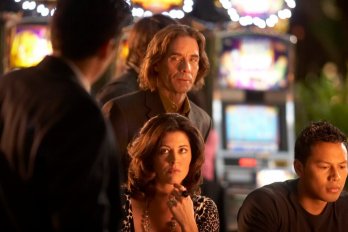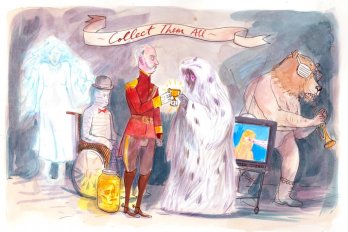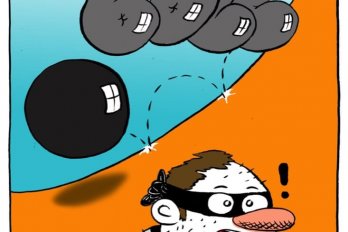The debate about print versus digital has become predictable, maybe because it feels like a familiar generational squabble, with fatalist laments on one side and callow dismissals on the other. Book lovers look at the Internet and envision the death of rigour, complexity, and deep, immersive reading. Tech heads view books at outmoded and one-dimensional, lacking the quick-silver connections of the web. Struan Sinclair doesn’t feel the need to take sides. Maybe it’s his perfectly poised age of thirty-seven: He grew up reading widely and playing video games. His first novel, Automatic World, is the kind of rich, reaching work for which books were made. But he is also developing an interactive digital fiction project called If/Then: A Walkthrough Fiction, which uses multimedia technology to deliver text. There’s no contradiction here: on the page or online, the Winnipeg-based writer is testing the ways we use language. And it’s not surprising that even as he is releasing a novel, he’s already wondering how the novel form — from conception right down to distribution — can be radically reimagined.
Sinclair has done many of the things emerging writers do. His debut story collection, Strange Comforts, was released in Canada in 1998, and republished to strong reviews a year later in the UK as Everything Breathed. (The Guardian called it “a genuinely exciting book.”) He spent 2002 and 2003 in the Orkney Islands on a writing fellowship, and in 2004 came to the University of Manitoba, where he teaches in the English department, specializing in creative writing and critical theory. But his literary profile is just a jumping-off point. He combines a strong technical streak — he’s director of U of M’s English Media Lab — with an omnivorous artistic drive. Growing up in Toronto, he attended the Claude Watson School for the Arts, specializing in music and theatre. He was a theatre junkie in high school and later at McGill. He has continued to do collaborative work with musicians and visual artists, in Canada and Britain, and his academic work is also resolutely interdisciplinary. (“I didn’t really take a lot of lit courses,” he admits.)
He speaks in a quiet rush of words (his first name means “babbling brook” in Scottish Gaelic), and his writing feels a lot like his speech, urgent but also carefully considered, the inevitable overflow of a restless, curious, and creative mind. As an undergraduate and master’s student at McGill, he was interested in literary computing and artificial intelligence — “They were big in the ’90s” — and his graduate work at Cardiff University involved cognitive psychology and philosophy of mind. A lot of his current research looks at how we parse texts, how our brains process words and sentences. “Literary theory does a lot of things well,” he says, “but we don’t have much of a story about how people write and how people read. I’m interested in what happens in the brain at a neurological level, and what happens in the mind at a cognitive level when we sit down to create.”
Automatic World is a train wreck of a book, and it’s meant to be. Sinclair has written a dark, crackling, experimental novel that circles around a catastrophic rail accident in Victorian England. A seemingly mechanistic chain of cause and effect — wet rails, defective welds, drunken brakemen — collapses into three lost minutes. This brief lacuna, which can’t be explained away by accumulated facts, somehow connects four characters across more than a century.
One of these, a nameless narrator identified in chapter titles only as “I,” is recovering from a traumatic brain injury. Sinclair, whose stacked CV includes work on neuropsychology, was intrigued by the image of a man trying to write himself back into being. “I was interested in someone who has only a present, who has lost the ability to narrate a sequence,” he notes. “What would it be like for a person to remember things but be completely unable to relate them, unable to represent himself to the world, and to have to make sense of all these competing versions of events?”
These competing versions, which emerge in alternating chapters, are doozies. Cal is a drug company employee. He spends his off-hours rescuing a father whose suicide attempts are so relentless and varied that they have taken on a mordantly funny life of their own. (“I get attracted to odd ideas,” admits Sinclair. “I loved the idea of suicide attempts being kind of like fishing — something a father and son did together to bond.”) Cal compulsively repeats his tale but can’t quite get it right: “There are some stories that refuse to settle.”
Dory’s story is equally unsettled. Growing up in a remote, rocky corner of North America, the daughter of feuding, preoccupied parents, she commits a mercy killing at a local hospice. As an aging woman, she tries to explain her actions in a never-ending letter, but finds herself writing around the ellipsis of that fatal hour.
Merrick is a nineteenth-century British inventor. An anonymous, put-upon assistant relates his chapters, in fevered accounts that combine a “fungal imagination” with remembered gobbets of an eccentric Victorian education (“Beavers, when vexed, will cry like young children”). As Merrick’s creations become more defiantly useless and strange, his household falls into Poe-like ruin.
Merrick’s assistant owns a watch engraved with just one word — “Grapple!” — and this seems like good advice when approaching Sinclair’s packed prose, a singular combination of discipline and word-hungry excess. A profligate researcher and lover of arcane subjects, he stuffs the novel with information about steam engines, Victorian medical devices, the manufacture of wax fruit, and the incremental decay of ghost towns. Each section possesses a characteristic texture: Cal’s descriptions of his work at the pharmaceutical giant take on the absurdist tone of a twenty-first-century office saga; Dory’s story is a wonderfully perverse take on the small-town coming-of-age tale; the narratives of Merrick’s assistant are framed with looming Gothic gloom and sensationalist nineteenth-century chapter headings (“A Shocking Incident Explained — More Misfortune”). However, the novel is not historical pastiche; Sinclair anchors all this cleverness with an assured, idiosyncratic voice that is very much his own, full of thorny particularities, evocative gaps, and sneaky deadpan comedy.
In quick flashes — a phrase, a gesture, the image of a girl stranded on a railway platform — the author suggests ways the central characters might be related, but Automatic World isn’t a puzzle to be solved. “This novel is animated by the desire to find patterns where that capability no longer exists,” he says. “You’ve got someone who’s desperately trying to haul into the narrative frame a series of actions that may be fictional, may not be, may have happened, may not have happened, but anyway he can’t make sense of them. We’re getting a story, but it’s made very clear up front that the story we’re getting is not meant to be the story of the case.” In the end, the novel’s components aren’t connected by clear causality but by elegiac emotion. All the characters are marked by loss and driven to construct narratives that will give heft and shape to their tragedies.
Some of these are train related, of course. A section in which the writer seems to be addressing the reader, and also himself, puts it this way: “You appreciate that the train is bound by certain laws: physical, temporal. But you also see that it is bound by narrative laws, story laws.” As much as it is about trains, Automatic World is about how we read and write. It teems with letters, diaries, and first-person accounts, but as Sinclair points out, “No one’s particularly interested in telling the truth.” The characters’ obsessive urge to write and rewrite expresses his belief that narratives inevitably take on lives of their own. “One of the things we do when we construct narratives is to subtly alter and change them. Research proves that.”
In Automatic World, the damaged narrator gingerly tries out verb tenses and struggles to connect events and words. Sinclair’s new digital literary project, If/Then, bumps these ideas out into time and space, using new technologies to investigate the ways people read and write. The hybrid work is set up as a virtual architectural tour, often called a fly-through or a walk-through, and begins with a disembodied voice describing the features of a contemporary structure. “You seem to be in a modern building, but bits of the building slide away,” Sinclair explains. “It exists in three concentric times, in 1880, 1950, and 2008, and it’s very easy for you to slip through time.” A reader — it would be more accurate to call her a user or a participant — walks through rooms and hallways, listening to PA announcements, dipping into documents and books, and holding interactive conversations with passing characters. Eventually, she pieces together the knowledge that the building is a mental institution haunted by its past.
The writing draws on material in the British Library archives, including lengthy interviews with patients who passed through the British mental health system in the 1940s, ’50s, and ’60s. Some of this subject matter was originally slated for Automatic World but mutated when Sinclair adapted it for a digital medium. The notion that an institution can possess a kind of physical memory took on poetic dimensions in the shifting corridors and corners of virtual space. The format also helped him explore the concept of time: “In If/Then, all the times exist simultaneously, which is something that’s very difficult to do in fiction.” As space and time become elastic, so does the identity of the reader/participant. “The user comes in as a visitor but is sometimes hailed as a patient,” he points out. In some ways, she is more active than a traditional reader, able to choose where she walks and what she touches, but in other ways she is much more controlled by the narrative. For example, Sinclair is currently looking at technologies that develop an avatar based on the user’s picture and real-life physical specs. “Once we have you, we can use you in all kinds of ways that you won’t know about,” he says. “As you move around, you might see yourself lying on a bed or projected onto a TV screen.”
But if the user doesn’t have complete control, neither does Sinclair. When If/Then is up and running, anyone will have online access, and some of the users’ actions and dialogue will stay in the story and become part of a constantly evolving “modular novel.” In a sense, Sinclair will be collaborating with people he’s never met. But if any writer seems ready to renounce the magnificent solitude and lordly control of the old-school novelist, it’s Sinclair. He’s got the theory down, having written academic papers on the subject, using the philosophy of action to look at the way people co-operate. “It turns out we shouldn’t be able to co-operate across distances, but we do,” he says. “We have cases of people collaborating on complex fictional worlds.” He’s also had practice, not just in the theatre world, but in the complicated set-up of If/Then as well. He’s finding Winnipeg a good place for this kind of work, with a crowded arts scene — he’s making connections with musicians and actors — and solid support on the technical side.
At a simplified level, the project works by the titular if/then principle: if response A, then B, if response C, then D, and so on. As the work develops, Sinclair will collect data about the way people interact with the texts. “We’ll be mapping how people navigate a narrative,” he says. “We’ll get a sense of how people read, at least online, how they make decisions in a virtual world.” He wants to see what happens when wide-open intentions jam up against syntactical and narrative limiting. “We think of writing as free expression, free play,” he says. “But of course it’s not. As soon as you write one word, you’ve limited all the other words. I look at writing as being a closing down of a huge array of options, one by one, so that’s kind of what this project will dramatize.”
Sinclair is aware of the dangers of digital media, of getting so caught up in the gee-whiz technological trappings that you don’t really think about how you want to use them. He recently saw a demonstration at a state-of-the-art virtual facility: “The technology was incredible. Stuff appeared before your eyes in three dimensions, and you could manipulate it. But the content was nowhere.” He sees a paradoxical kind of underachievement in a lot of these projects, with head-bustingly advanced technologies being used to deliver dull, derivative, weirdly old-fashioned stories. “A lot of online narratives are terrible; they’re just not good,” he concedes. Some digital work seems stuck in that transitional phase in which people use a new medium according to the rules of the old medium. (An example would be nineteenth-century photographers, who often composed their photographs to resemble paintings.)
Sinclair acknowledges that some people believe digital fiction will lead to the slow death of books. But he doesn’t view the situation as adversarial; he sees it as an opportunity for exciting, expansive cross-fertilization. He says new media has brought innovative methods of production and distribution to writing. (Right now, he’s looking at producing electronic chapbooks involving writers from all over the world.) He thinks it’s time for writing to come to new media — to see how narrative forms can stretch and evolve in digital frameworks. “How can I say this without sounding grandiose?” he says, looking apologetic. “I’m interested in a radical rethinking of what a novel is. It seems to me that it’s time to reimagine the novel as an active, dynamic space involving multiple authors and multiple readers, potentially working simultaneously.” In Automatic World, he breaks open the seams of an old art form; in the If/Then project, he is starting with a new form and struggling to give it the complexity and subtlety of art. His work is all of a piece — and not likely to exterminate books.
“People will always read books,” says Struan Sinclair. They’ll always write them, for that matter. And sure enough, he is already working on his next hard-copy novel, although, true to form, he’s collaborating with an illustrator.





